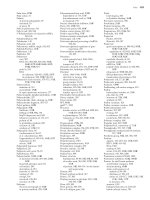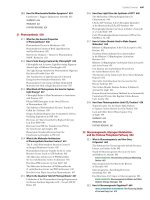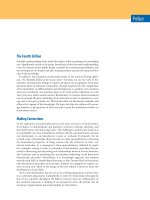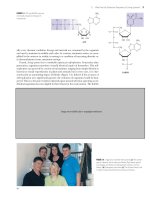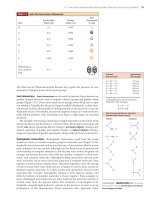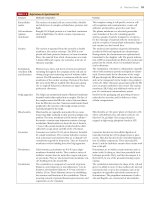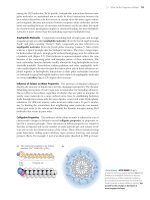Biochemistry, 4th Edition P19 potx
Bạn đang xem bản rút gọn của tài liệu. Xem và tải ngay bản đầy đủ của tài liệu tại đây (1.19 MB, 10 trang )
6.3 What Are the Elements of Secondary Structure in Proteins, and How Are They Formed? 143
by Pauling and Corey in 1951 and has now been observed in many natural proteins.
A -pleated sheet can be visualized by laying thin, pleated strips of paper side by side
to make a “pleated sheet” of paper (Figure 6.10). Each strip of paper can then be
pictured as a single peptide strand in which the peptide backbone makes a zigzag
pattern along the strip, with the ␣-carbons lying at the folds of the pleats. The
pleated sheet can exist in both parallel and antiparallel forms. In the parallel
-pleated sheet, adjacent chains run in the same direction. In the antiparallel -
pleated sheet, adjacent strands run in opposite directions.
Each single strand of the -sheet structure can be pictured as a twofold helix,
that is, a helix with two residues per turn. The arrangement of successive amide
planes has a pleated appearance due to the tetrahedral nature of the C
␣
atom. It
is important to note that the hydrogen bonds in this structure are essentially in-
ter strand rather than intrastrand. Optimum formation of H bonds in the parallel
pleated sheet results in a slightly less extended conformation than in the anti-
parallel sheet. The H bonds thus formed in the parallel -sheet are bent signifi-
cantly. The distance between residues is 0.347 nm for the antiparallel pleated
sheet, but only 0.325 nm for the parallel pleated sheet. Note that the side chains
in the pleated sheet are oriented perpendicular or normal to the plane of the
sheet, extending out from the plane on alternating sides.
Parallel -sheets tend to be more regular than antiparallel -sheets. As can be
seen in Figure 6.4, typical , values for a parallel -sheet are ϭϪ120°, ϭ105°,
and typical values for an anti-parallel -sheet are ϭϪ135°, ϭ140°. However,
the range of and angles for the peptide bonds in parallel sheets is much smaller
than that for antiparallel sheets. Parallel sheets are typically large structures; those
CRITICAL DEVELOPMENTS IN BIOCHEMISTRY
In Bed with a Cold, Pauling Stumbles onto the ␣-Helix and a Nobel Prize*
As high technology continues to transform the modern biochem-
ical laboratory, it is interesting to reflect on Linus Pauling’s dis-
covery of the ␣-helix. It involved only a piece of paper, a pencil,
scissors, and a sick Linus Pauling, who had tired of reading detec-
tive novels. The story is told in the excellent book The Eighth Day
of Creation by Horace Freeland Judson:
From the spring of 1948 through the spring of 1951…rivalry sput-
tered and blazed between Pauling’s lab and (Sir Lawrence)
Bragg’s—over protein. The prize was to propose and verify in nature
a general three-dimensional structure for the polypeptide chain.
Pauling was working up from the simpler structures of components.
In January 1948, he went to Oxford as a visiting professor for two
terms, to lecture on the chemical bond and on molecular structure
and biological specificity. “In Oxford, it was April, I believe, I caught
cold. I went to bed, and read detective stories for a day, and got
bored, and thought why don’t I have a crack at that problem of
alpha keratin.” Confined, and still fingering the polypeptide chain
in his mind, Pauling called for paper, pencil, and straightedge and
attempted to reduce the problem to an almost Euclidean purity. “I
took a sheet of paper—I still have this sheet of paper—and drew,
rather roughly, the way that I thought a polypeptide chain would
look if it were spread out into a plane.” The repetitious herringbone
of the chain he could stretch across the paper as simply as this—
—putting in lengths and bond angles from memory.…He knew that
the peptide bond, at the carbon-to-nitrogen link, was always rigid:
And this meant that the chain could turn corners only at the alpha
carbons.…“I creased the paper in parallel creases through the alpha
carbon atoms, so that I could bend it and make the bonds to the
alpha carbons, along the chain, have tetrahedral value. And then I
looked to see if I could form hydrogen bonds from one part of the
chain to the next.” He saw that if he folded the strip like a chain of
paper dolls into a helix, and if he got the pitch of the screw right,
hydrogen bonds could be shown to form, NOH
Z
OOC, three or
four knuckles apart along
the backbone, holding the helix in shape.
After several tries, changing the angle of the parallel creases in order
to adjust the pitch of the helix, he found one where the hydrogen
bonds would drop into place, connecting the turns, as straight lines
of the right length. He had a model.
*The discovery of the ␣-helix structure was only one of many achievements
that led to Pauling’s Nobel Prize in Chemistry in 1954. The official citation
for the prize was “for his research into the nature of the chemical bond
and its application to the elucidation of the structure of complex
substances.”
C
N
(a)
H
O
C
N
C
N
C
C
N
C
C
C
N
C
␣
C
␣␣
␣␣
(b)
OOH H
O OH H
HR
HR
HR H
R
HR
Go to CengageNOW at www
.cengage.com/login and click BiochemistryInteractive
to explore -sheets, one of the principal types of sec-
ondary structure in proteins.
144 Chapter 6 Proteins: Secondary,Tertiary, and Quaternary Structure
composed of less than five strands are rare. Antiparallel sheets, however, may con-
sist of as few as two strands. Parallel sheets characteristically distribute hydrophobic
side chains on both sides of the sheet, whereas antiparallel sheets are usually
arranged with all their hydrophobic residues on one side of the sheet. This requires
an alternation of hydrophilic and hydrophobic residues in the primary structure of
peptides involved in antiparallel -sheets because every other side chain projects to
the same side of the sheet (Figure 6.10).
Antiparallel pleated sheets are the fundamental structure found in the fabric we
know as silk, with the polypeptide chains forming the sheets running parallel to the
silk fibers. The silk fibers thus formed have properties consistent with those of the
-sheets that form them. They are quite flexible but cannot be stretched or
extended to any appreciable degree.
Helix–Sheet Composites in Spider Silk
Although the intricate designs of spider webs are eye- (and fly-) catching, it might
be argued that the composition of web silk itself is even more remarkable. Spider
silk (a form of keratin) is synthesized in special glands in the spider’s abdomen. The
silk strands produced by these glands are both strong and elastic. Dragline silk (that
from which the spider hangs) has a tensile strength of 200,000 psi (pounds per
square inch)—stronger than steel and similar to Kevlar, the synthetic material used
in bulletproof vests! This same silk fiber is also flexible enough to withstand strong
winds and other natural stresses. This combination of strength and flexibility de-
rives from the composite nature of spider silk. As keratin protein is extruded from the
spider’s glands, it endures shearing forces that break the H bonds stabilizing keratin
␣-helices (Figure 6.11). These regions then form microcrystalline arrays of -sheets.
These microcrystals are surrounded by the keratin strands, which adopt a highly
disordered state composed of ␣-helices and random coil structures. The -sheet mi-
crocrystals contribute strength, and the disordered array of helix and coil make the
silk strand flexible. The resulting silk strand resembles modern human-engineered
composite materials. Certain tennis racquets, for example, consist of fiberglass poly-
mers impregnated with microcrystalline graphite. The fiberglass provides flexibility,
and the graphite crystals contribute strength.
FIGURE 6.10 A “pleated sheet”of paper with an antiparallel -sheet drawn on it. (Illustration: Irving Geis. Rights
owned by Howard Hughes Medical Institute. Not to be reproduced without permission.)
6.3 What Are the Elements of Secondary Structure in Proteins, and How Are They Formed? 145
-Turns Allow the Protein Strand to Change Direction
Most proteins are globular structures. The polypeptide chain must therefore pos-
sess the capacity to bend, turn, and reorient itself to produce the required compact,
globular structures. A simple structure observed in many proteins is the -turn (also
known as the tight turn or -bend), in which the peptide chain forms a tight loop with
the carbonyl oxygen of one residue hydrogen bonded with the amide proton of the
residue three positions down the chain. This H bond makes the -turn a relatively
stable structure. As shown in Figure 6.12, the -turn allows the protein to reverse
the direction of its peptide chain. This figure shows the two major types of -turns,
but a number of less common types are also found in protein structures. Because it
lacks a side chain, glycine is sterically the most adaptable of the amino acids, and it
accommodates conveniently to other steric constraints in the -turn. Proline, how-
(a) Spider web
(b) Radial strand
Ordered -sheets surrounded
by disordered ␣-helices and
-bends.
(c)
(d) -sheets impart strength and
␣-helices impart flexibility
to the strand.
FIGURE 6.11 Spider web silks are composites of ␣-helices and -sheets.The radial strands of webs must be
strong and rigid; silks in radial strands contain a higher percentage of -sheets.The circumferential strands
(termed capture silk) must be flexible (to absorb the impact of flying insects); capture silk contains a higher
percentage of ␣-helices. Spiders typically have several different silk gland spinnerets, which secrete different
silks of differing composition. Spiders have inhabited the earth for about 470 million years.
N
O
α
2
N
O
α
4
C
C
C
C
C
C
R
2
N
α
3
R
3
α
1
N
O
α
2
O
N
O
N
α
1
α
4
O
α
3
R
3
R
2
FIGURE 6.12 The structures of two kinds of -turns (also called tight turns or -bends). Four residues are re-
quired to form a -turn. Left:Type I; right:Type II. (Illustration: Irving Geis. Rights owned by Howard Hughes Medical Insti-
tute. Not to be reproduced without permission.)
Go to CengageNOW at www
.cengage.com/login and click BiochemistryInteractive
to discover the features of -turns and how they
change the course of a polypeptide strand.
146 Chapter 6 Proteins: Secondary,Tertiary, and Quaternary Structure
ever, has a cyclic structure and a fixed angle, so, to some extent, it forces the for-
mation of a -turn; in many cases this facilitates the turning of a polypeptide chain
upon itself. Such bends promote formation of antiparallel -pleated sheets. Type I
turns (Figure 6.12) are more common than type II. Proline fits best in the 3 posi-
tion of the type I turn. In the type II turn, proline is preferred at the 2 position,
whereas the 3 position prefers glycine or small polar residues.
6.4 How Do Polypeptides Fold into Three-Dimensional
Protein Structures?
The arrangement of all atoms of a single polypeptide chain in three-dimensional
space is referred to as its tertiary structure. As discussed in Section 6.2 all of the in-
formation needed to fold the protein into its native tertiary structure is contained
within the primary structure of the peptide chain itself. Sometimes proteins known as
chaperones assist in the process of protein folding in the cell, but proteins in dilute
solution can be unfolded and refolded without the assistance of such chaperones.
The first determinations of the tertiary structure of a protein were by John Kendrew
and Max Perutz. Kendrew’s structure of myoglobin and Perutz’s structure of hemo-
globin, reported in the late 1950s, were each the result of more than 20 years of work.
Ever since these first protein structures were elucidated, biochemists have sought to
understand the principles by which proteins adopt their remarkable structures. Vigor-
ous work in many laboratories has slowly brought important principles to light:
• Secondary structures—helices and sheets—form whenever possible as a conse-
quence of the formation of large numbers of hydrogen bonds.
• ␣-Helices and -sheets often associate and pack close together in the protein. No
protein is stable as a single-layer structure, for reasons that become apparent
later. There are a few common methods for such packing to occur.
• Because the peptide segments between secondary structures in the protein tend
to be short and direct, the peptide does not execute complicated twists and knots
as it moves from one region of secondary structure to another.
• Proteins generally fold so as to form the most stable structures possible. The sta-
bility of most proteins arises from (1) the formation of large numbers of in-
tramolecular hydrogen bonds and (2) the reduction in the surface area accessi-
ble to solvent that occurs upon folding.
Two factors lie at the heart of these four “principles.” First, proteins are typically
a mixture of hydrophilic and hydrophobic amino acids. Why is this important?
Imagine a protein that is composed only of polar and charged amino acids. In such
a protein, every side chain could hydrogen bond to water. This would leave no rea-
son for the protein to form a compact, folded structure.
Now consider a protein composed of a mixture of hydrophilic and hydrophobic
residues. In this case, the hydrophobic side chains cannot form H bonds with water,
and their presence will disrupt the hydrogen-bonding structure of water itself. To
minimize this, the hydrophobic groups will tend to cluster together. This hydrophobic effect in-
duces formation of a compact structure—the folded protein.
A potential problem with this rather simple folding model is that polar backbone
NOH and CP
O groups on the hydrophobic residues accompany the hydrophobic
side chains into the folded protein interior. This would be energetically costly to the
protein, but the actual result is that the polar backbone groups form H bonds with
one another, so that the polar backbone NOH and CPO moieties are stabilized in
␣-helices and -sheets in the protein interior.
Fibrous Proteins Usually Play a Structural Role
In Chapter 5, we saw that proteins can be grouped into three large classes based on
their structure and solubility: fibrous proteins, globular proteins, and membrane proteins.
Fibrous proteins contain polypeptide chains organized approximately parallel
6.4 How Do Polypeptides Fold into Three-Dimensional Protein Structures? 147
along a single axis, producing long fibers or large sheets. Such proteins tend to be
mechanically strong and resistant to solubilization in water and dilute salt solutions.
Fibrous proteins often play a structural role in nature (see Chapter 5).
␣-Keratin The ␣-keratins are the predominant constituents of claws, fingernails,
hair, and horns in mammals. As their name suggests, the structure of the ␣-keratins
is dominated by ␣-helical segments of polypeptide. The amino acid sequence of
␣-keratin subunits is composed of central ␣-helix–rich rod domains about 311 to
314 residues in length, flanked by nonhelical N- and C-terminal domains of varying
size and composition (Figure 6.13a). The structure of the central rod domain of a
typical ␣-keratin is shown in Figure 6.13b. Pairs of right-handed ␣-helices wrap
around each other to form a left-twisted coiled coil. X-ray diffraction data (includ-
ing the original studies by William Astbury) show that these structures resemble
␣-helices, but with a pitch of 0.51 nm rather than the expected 0.54 nm. This is con-
sistent with a tilt of the helix relative to the long axis of the coiled coil (and the ker-
atin fiber) in Figure 6.13.
The amino acid sequence of the central rod segments of ␣-keratin consists of
quasi-repeating 7-residue segments of the form (a-b-c-d-e-f-g)
n
. These units are not
true repeats, but residues a and d are usually nonpolar amino acids. In ␣-helices,
with 3.6 residues per turn, these nonpolar residues are arranged in an inclined row
or stripe that twists around the helix axis (Figure 6.13c). These nonpolar residues
would make the helix highly unstable if they were exposed to solvent, but the asso-
ciation of hydrophobic stripes on two ␣-helices to form the two-stranded coiled coil
effectively buries the hydrophobic residues and forms a highly stable structure
N-terminal
domain
(a)
H
3
+
N
Rod
domain
C-terminal
domain
Keratin
type I
**
35
11
14
101 16 19 8 121
**
COO
–
H
3
+
N
**
35 101 17 19 8 121
*
COO
–
36 12 20 20
Keratin
type II
(b)
␣-Helix
Coiled coil of two ␣-helices
Protofilament (pair of coiled coils)
Filament (four right-hand twisted protofibrils)
(c) Periodicity of hydrophobic residues
Undistorted
N
Supercoiled Left-handed coiled coil
Helices with a heptad repeat
of hydrophobic residues
FIGURE 6.13 (a) Both type I and type II ␣-keratin molecules have sequences consisting of long, central rod do-
mains with terminal cap domains.The numbers of amino acid residues in each domain are indicated. Asterisks
denote domains of variable length. (b) The rod domains form coiled coils consisting of left-twisted right-
handed ␣-helices. These coiled coils form protofilaments that then wind around each other in a right-handed
twist. Keratin filaments consist of twisted protofibrils (each a bundle of four coiled coils). (c) Periodicity of hy-
drophobic residues.
(Adapted from Steinert, P., and Parry, D., 1985. Intermediate filaments: Conformity and diversity of expres-
sion and structure. Annual Review of Cell Biology 1:41–65; and Cohlberg, J., 1993.Textbook error: The structure of alpha-keratin.
Trends in Biochemical Sciences 18:360–362.)
148 Chapter 6 Proteins: Secondary,Tertiary, and Quaternary Structure
A DEEPER LOOK
The Coiled-Coil Motif in Proteins
The coiled-coil motif was first identified in 1953 by Linus Pauling,
Robert Corey, and Francis Crick as the main structural element of
fibrous proteins such as keratin and myosin. Since then, many pro-
teins have been found to contain one or more coiled-coil seg-
ments or domains. A coiled coil is a bundle of ␣-helices that are
wound into a superhelix. Two, three, or four helical segments may
be found in the bundle, and they may be arranged parallel or an-
tiparallel to one another. Coiled coils are characterized by a dis-
tinctive and regular packing of side chains in the core of the bun-
dle. This regular meshing of side chains requires that they occupy
equivalent positions turn after turn. This is not possible for undis-
torted ␣-helices, which have 3.6 residues per turn. The positions of
side chains on their surface shift continuously along the helix sur-
face (see Figure 6.13c). However, giving the right-handed ␣-helix
a left-handed twist reduces the number of residues per turn to 3.5,
and because 3.5 ϫ 2 ϭ 7.0, the positions of the side chains repeat
after two turns (7 residues). Thus, a heptad repeat pattern in the
peptide sequence is diagnostic of a coiled-coil structure. The fig-
ure shows a sampling of coiled-coil structures (highlighted in
color) in various proteins.
(a) Coiled coil
Pitch
Influenza hemagglutinin GCN4 leucine/isoleucine
mutant
(b)
Seryl tRNA synthetase DNA
p
olymerase Catabolite activator
p
rotein
Test yourself on the concepts in this figure at www.cengage.com/login
6.4 How Do Polypeptides Fold into Three-Dimensional Protein Structures? 149
(Figure 6.13). The helices clearly sacrifice some stability in assuming this twisted
conformation, but they gain stabilization energy from the packing of side chains be-
tween the helices. In other forms of keratin, covalent disulfide bonds form between
cysteine residues of adjacent molecules, making the overall structure even more
rigid, inextensible, and insoluble—important properties for structures such as
claws, fingernails, hair, and horns. How and where these disulfides form determines
the amount of curling in hair and wool fibers. When a hairstylist creates a perma-
nent wave (simply called a “permanent”) in a hair salon, disulfides in the hair are
first reduced and cleaved, then reorganized and reoxidized to change the degree of
curl or wave. In contrast, a “set” that is created by wetting the hair, setting it with
curlers, and then drying it represents merely a rearrangement of the hydrogen
bonds between helices and between fibers. (On humid or rainy days, the hydrogen
bonds in curled hair may rearrange, and the hair becomes “frizzy.”)
Fibroin and -Keratin: -Sheet Proteins The fibroin proteins found in silk fibers
in the cocoons of the silkworm, Bombyx mori, and also in spiderwebs represent an-
other type of fibrous protein. These are composed of stacked antiparallel -sheets,
as shown in Figure 6.14. In the polypeptide sequence of silk proteins, there are
large stretches in which every other residue is a glycine. As previously mentioned,
the residues of a -sheet extend alternately above and below the plane of the sheet.
As a result, the glycines all end up on one side of the sheet and the other residues
(mainly alanines and serines) compose the opposite surface of the sheet. Pairs of
-sheets can then pack snugly together (glycine surface to glycine surface or
alanine–serine surface to alanine—serine surface). The -keratins found in bird
feathers are also made up of stacked -sheets.
Ala
Ala
Gly
Gly
Ala
Ala
Gly
Gly
Ala
Ala
Ala
Ala
Ala
Ala
Gly
Gly
Gly
Gly
Gly
Gly
FIGURE 6.14 Silk fibroin consists of a unique stacked array of -sheets.The primary structure of fibroin molecules
consists of long stretches of alternating glycine and alanine or serine residues.When the sheets stack, the more
bulky alanine and serine residues on one side of a sheet interdigitate with similar residues on an adjoining sheet.
Glycine hydrogens on the alternating faces interdigitate in a similar manner,but with a smaller intersheet spacing.
(Illustration: Irving Geis. Rights owned by Howard Hughes Medical Institute. Not to be reproduced without permission.)
150 Chapter 6 Proteins: Secondary,Tertiary, and Quaternary Structure
Collagen: A Triple Helix Collagen is a rigid, inextensible fibrous protein that is a
principal constituent of connective tissue in animals, including tendons, cartilage,
bones, teeth, skin, and blood vessels. The high tensile strength of collagen fibers in
these structures makes possible the various animal activities such as running and
jumping that put severe stresses on joints and skeleton. Broken bones and tendon
and cartilage injuries to knees, elbows, and other joints involve tears or hyperex-
tensions of the collagen matrix in these tissues.
The basic structural unit of collagen is tropocollagen, which has a molecular
weight of 285,000 and consists of three intertwined polypeptide chains, each about
1000 amino acids in length. Tropocollagen molecules are about 300 nm long and
only about 1.4 nm in diameter. Several kinds of collagen have been identified. Type
I collagen, which is the most common, consists of two identical peptide chains des-
ignated ␣1(I) and one different chain designated ␣2(I). Type I collagen predomi-
nates in bones, tendons, and skin. Type II collagen, found in cartilage, and type III col-
lagen, found in blood vessels, consist of three identical polypeptide chains.
Collagen has an amino acid composition that is unique and is crucial to its three-
dimensional structure and its characteristic physical properties. Nearly one residue
out of three is a glycine, and the proline content is also unusually high. Three un-
usual modified amino acids are also found in collagen: 4-hydroxyproline (Hyp),
3-hydroxyproline, and 5-hydroxylysine (Hyl) (Figure 4.4). Proline and Hyp together
compose up to 30% of the residues of collagen. Interestingly, these three amino
acids are formed from normal proline and lysine after the collagen polypeptides are
synthesized. The modifications are effected by two enzymes: prolyl hydroxylase and
lysyl hydroxylase. The prolyl hydroxylase reaction (Fig
ure 6.15) requires molecular
oxygen, ␣-ketoglutarate, and ascorbic acid (vitamin C) and is activated by Fe
2ϩ
. The
hydroxylation of lysine is similar.
Because of their high content of glycine, proline, and hydroxyproline, collagen
fibers are incapable of forming traditional structures such as ␣-helices and -sheets.
Instead, collagen polypeptides intertwine to form a unique right-handed triple helix,
with each of the three strands arranged in a left-handed helical fashion (Figure
6.16). Compared to the ␣-helix, the collagen helix is much more extended, with a
H
CN C
O
CH
2
H
2
C
C
H
H
Proline
++
COO
–
CH
2
CH
2
COO
–
C O
␣-Ketoglutarate
O
OH
HO
Ascorbic
acid
O
Prolyl hydroxylase
Fe
2+
H
CN
C
O
CH
2
H
2
C
C
H
OH
Hydroxyproline
++
COO
–
CH
2
CH
2
O
–
C O
Succinate
O
O
Dehydroascorbate
O
O
H
+
H
H
2
C
OH
H
COH
H
2
C
OH
H
COH
+
O
2
CO
2
FIGURE 6.15 Hydroxylation of proline residues is catalyzed by prolyl hydroxylase.The reaction requires
␣-ketoglutarate and ascorbic acid (vitamin C).
6.4 How Do Polypeptides Fold into Three-Dimensional Protein Structures? 151
rise per residue along the triple helix axis of 2.9 Å (versus 1.5 Å for the ␣-helix).
There are about 3.3 residues per turn of each of these helices. The triple helix is a struc-
ture that forms to accommodate the unique composition and sequence of collagen. Long
stretches of the polypeptide sequence are repeats of a Gly-x-y motif, where x is fre-
quently Pro and y is frequently Pro or Hyp. In the triple helix, every third residue
faces or contacts the crowded center of the structure. This area is so crowded that
only Gly can fit, and thus every third residue must be a Gly (as observed). Moreover,
the triple helix is a staggered structure, such that Gly residues from the three strands
stack along the center of the triple helix and the Gly from one strand lies adjacent
to an x residue from the second strand and to a y from the third. This allows the
NOH of each Gly residue to hydrogen bond with the CPO of the adjacent x residue.
The triple helix structure is further stabilized and strengthened by the formation of
interchain H bonds involving hydroxyproline.
Collagen types I, II, and III form strong, organized fibrils, which consist of stag-
gered arrays of tropocollagen molecules (Figure 6.17). The periodic arrangement
of triple helices in a head-to-tail fashion results in banded patterns in electron mi-
crographs. The banding pattern typically has a periodicity (repeat distance) of
68 nm. Because collagen triple helices are 300 nm long, 40-nm gaps occur between
adjacent collagen molecules in a row along the long axis of the fibrils and the pat-
tern repeats every five rows (5 ϫ 68 nm ϭ 340 nm). The 40-nm gaps are referred
to as hole regions, and they are important in at least two ways. First, sugars are found
covalently attached to 5-hydroxylysine residues in the hole regions of collagen
(Figure 6.18). The occurrence of carbohydrate in the hole region has led to the
proposal that it plays a role in organizing fibril assembly. Second, the hole regions
may play a role in bone formation. Bone consists of microcrystals of hydroxyap-
atite, Ca
5
(PO
4
)
3
OH, embedded in a matrix of collagen fibrils. When new bone tis-
sue forms, the formation of new hydroxyapatite crystals occurs at intervals of
68 nm. The hole regions of collagen fibrils may be the sites of nucleation for the
mineralization of bone.
ACTIVE FIGURE 6.16 Poly(Gly-Pro-Pro),
a collagenlike right-handed triple helix composed of
three left-handed helical chains (pdb id ϭ 1K6F).
(Adapted from Miller, M. H., and Scheraga, H. A., 1976. Calculation
of the structures of collagen models. Role of interchain interac-
tions in determining the triple-helical coiled-coil conformation. I.
Poly(glycyl-prolyl-prolyl). Journal of Polymer Science Symposium
54:171–200.)
Test yourself on the concepts in this fig-
ure at www.cengage.com/login.
Overlap zone
0.4d
Hole zone
0.6d
Packing of collagen molecules
FIGURE 6.17 In the electron microscope, collagen fibers exhibit alternating light and dark bands.The dark bands
correspond to the 40-nm gaps or “holes”between pairs of aligned collagen triple helices.The repeat distance, d,
for the light- and dark-banded pattern is 68 nm.The collagen molecule is 300 nm long, which corresponds to
4.41d.The molecular repeat pattern of five staggered collagen molecules corresponds to 5d.
J. Gross, Biozentrum/Science Photo Library
CH
2
OH
O
HO
H
H
OH H
O CH
CH
2
NH
3
+
CH
2
CH
2
C
H
C
O
N
H
H
CH
2
OH
O
H
OH
H
OH H
HOH
H
Glucose
Galactose
Hydroxylysine
residue
H
O
FIGURE 6.18 A disaccharide of galactose and glucose is
covalently linked to the 5-hydroxyl group of hydroxy-
lysines in collagen by the combined action of the en-
zymes galactosyltransferase and glucosyltransferase.
152 Chapter 6 Proteins: Secondary,Tertiary, and Quaternary Structure
Globular Proteins Mediate Cellular Function
Fibrous proteins, although interesting for their structural properties, represent only
a small percentage of the proteins found in nature. Globular proteins, so named for
their approximately spherical shape, are far more numerous. The diversity of pro-
tein structures found in nature reflects the remarkable variety of functions per-
formed by proteins—binding, catalysis, regulation, transport, immunity, cellular sig-
naling, and more. The functional diversity and versatility derive in turn from (1) the
large number of folded structures that polypeptide chains can adopt and (2) the
varied chemistry of the side chains of the 20 common amino acids. Remarkably, this
diversity of structure and function derives from a relatively small number of princi-
ples and themes of protein folding and design. The balance of Chapter 6 explores
and elaborates these principles and themes.
Helices and Sheets Make up the Core of Most Globular Proteins
Globular proteins exist in an enormous variety of three-dimensional structures, but
nearly all contain substantial amounts of ␣-helices and -sheets folded into a com-
pact structure that is stabilized by both polar and nonpolar groups. A typical exam-
ple is bovine ribonuclease A, a small protein (12.6 kD, 124 residues) that contains a
few short ␣-helices, a broad section of antiparallel -sheet, a few -turns, and several
peptide segments without defined secondary structure (Figure 6.19). The space be-
tween the helices and sheets in the protein interior is filled efficiently and tightly
with mostly hydrophobic amino acid side chains. Most polar side chains in ribonu-
clease face the outside of the protein structure and interact with solvent water. With
its hydrophobic core and a hydrophilic surface, ribonuclease illustrates the typical
properties of many folded globular proteins.
The helices and sheets that make up the core of most globular proteins probably
represent the starting point for protein folding, as shown later in this chapter. Thus,
the folding of a globular protein, in its simplest conception, could be viewed rea-
sonably as the condensation of multiple elements of secondary structure. On the
other hand, most peptide segments that form helices, sheets, or beta turns in pro-
teins are mostly disordered in small model peptides that contain those amino acid
sequences. Thus hydrophobic interactions and other noncovalent interactions with
the rest of the protein must stabilize these relatively unstable helices, sheets, and
turns in the whole folded protein.
Why should the cores of most globular and membrane proteins consist almost
entirely of ␣-helices and -sheets? The reason is that the highly polar NOH and
CPO moieties of the peptide backbone must be neutralized in the hydrophobic
(a)
(b)
ACTIVE FIGURE 6.19 The three-
dimensional structure of bovine ribonuclease A (pdb id
ϭ 1FS3). (a) Ribbon diagram; (b) space-filling model.
(Jane Richardson.) Test yourself on the concepts in this
figure at www.cengage.com/login
